Imagine you’re a content marketer and your client is in the exciting world of selling world-class travel destination packages. You’ve got plenty of organic traffic, and let’s admit it, the excitement and appeal of the experience almost markets itself.
But what about less glamorous niche industries? Or those that don’t acquire as much organic search traffic? It’s easier to market something aspirational like travel, than let’s say, a concrete manufacturer.
In this blog, we’ll provide actionable tips to improve your content marketing strategy and identify new, creative ways of building successful content in niche industries.
Ready to get started?
Use our free workbook to follow along.
Research Methodology
To come out on the other side of these content marketing challenges, we need to look at the trends in several industries as a whole.
In our State of Content Marketing 2022 Global Report, we selected 10 industries with the highest cost per click (CPC) to establish trends and benchmarks.
Why did we choose the most expensive industries to advertise, you ask? When advertising is costly, many companies turn to organic channels to yield long-term results.
We then analyzed 8,435 articles that received the most traffic between October 2020 to October 2021, examining their traffic sources, backlinks, organic keywords data, organic traffic, as well as the common patterns related to content types and engagement.
Next, we turned to the experts in various niche industries who shed light on creative and technical strategies that work best for them.
The 10 industries with the highest CPC we researched include:
- Advertising and marketing
- Banking
- Beauty
- Distance learning
- Insurance
- Internet and telecom
- Jewelry
- Legal
- Real Estate
- Travel
Benchmarking Content Marketing Performance and Trends
What were the most impactful correlations we found in our study? By examining keywords, organic traffic, social media engagement, and content types, our study delivers several takeaways that content marketers can use to benchmark their efforts in 2022.
Industry Blogs: Performance by Organic Keywords
What we did: We looked at the median number of organic keywords for our 10 selected industries, revealing the average number of keyword opportunities for each niche. The results below indicate the number of keywords per average blog post or article:
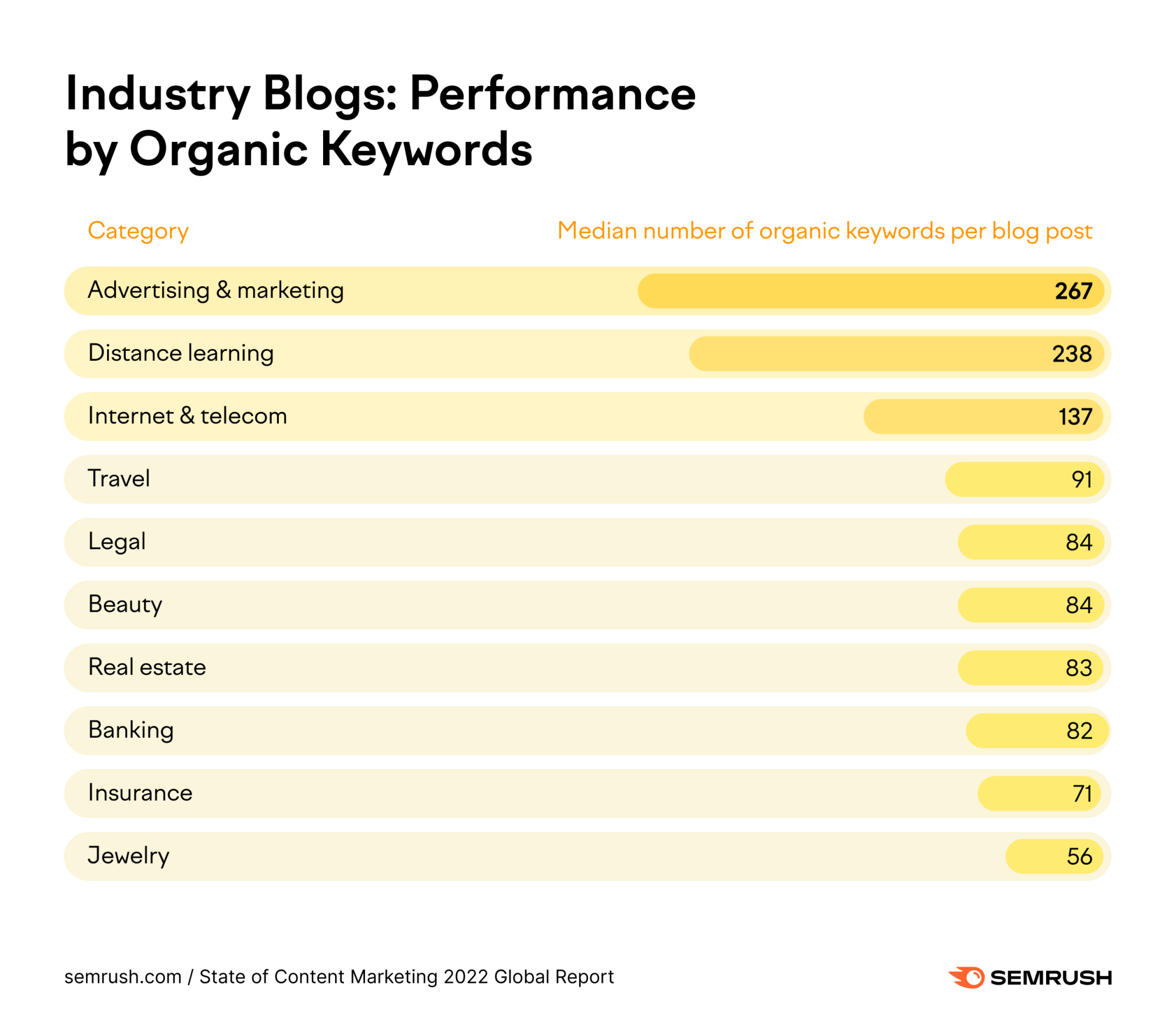
Key takeaway: In all industries, search always leads the way as the top traffic source. Distance learning and advertising and marketing have a significantly higher number of median organic keywords. So, it could be a good idea to learn from businesses in these sectors.
Industry Blogs: Performance by Organic Traffic
What we did: Using data from Semrush’s Traffic Analytics, we calculated the median number of backlinks, organic keywords, and monthly organic views per average blog post in each industry category.
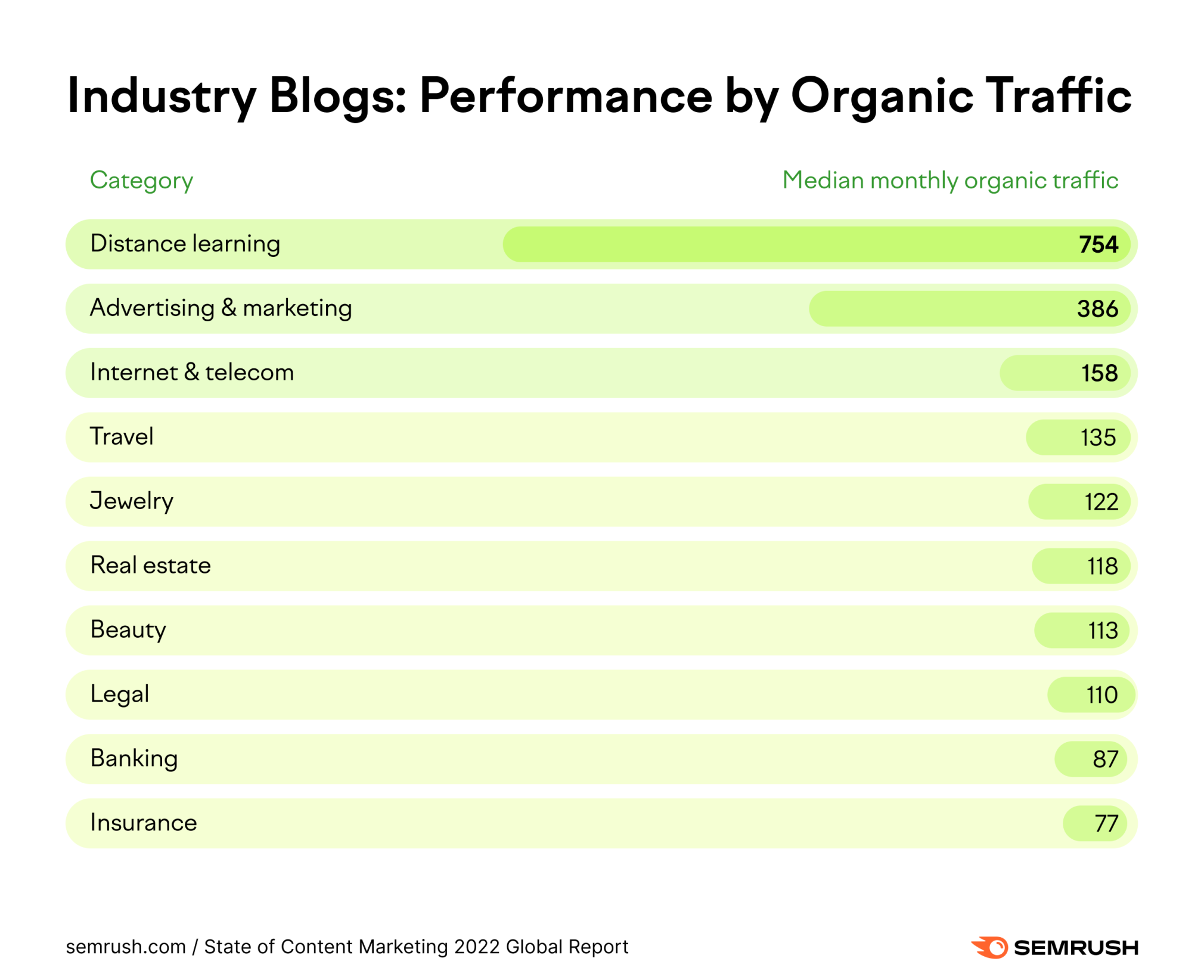
Key takeaway: Again, we see that distance learning and advertising and marketing attract significantly more organic visits than other industries, with distance learning almost doubling that of the advertising and marketing industry.
Industry Blogs: Performance by Social Media Engagement
What we did: We determined engagement in top-performing content, defined by average Facebook engagements (shares, comments, and reactions), across each of our chosen industry categories.

Key takeaway: Travel and tourism get the lion’s share of social engagement on Facebook. They outperform every other industry across all three criteria: likes, shares, and reactions.
Industry Blogs Top-Performing Articles: by Article Type
What were the top-performing article types? Using data from the Content Marketing Platform, we identified articles from each of the industry blogs and categorized the types of content seen in that space.
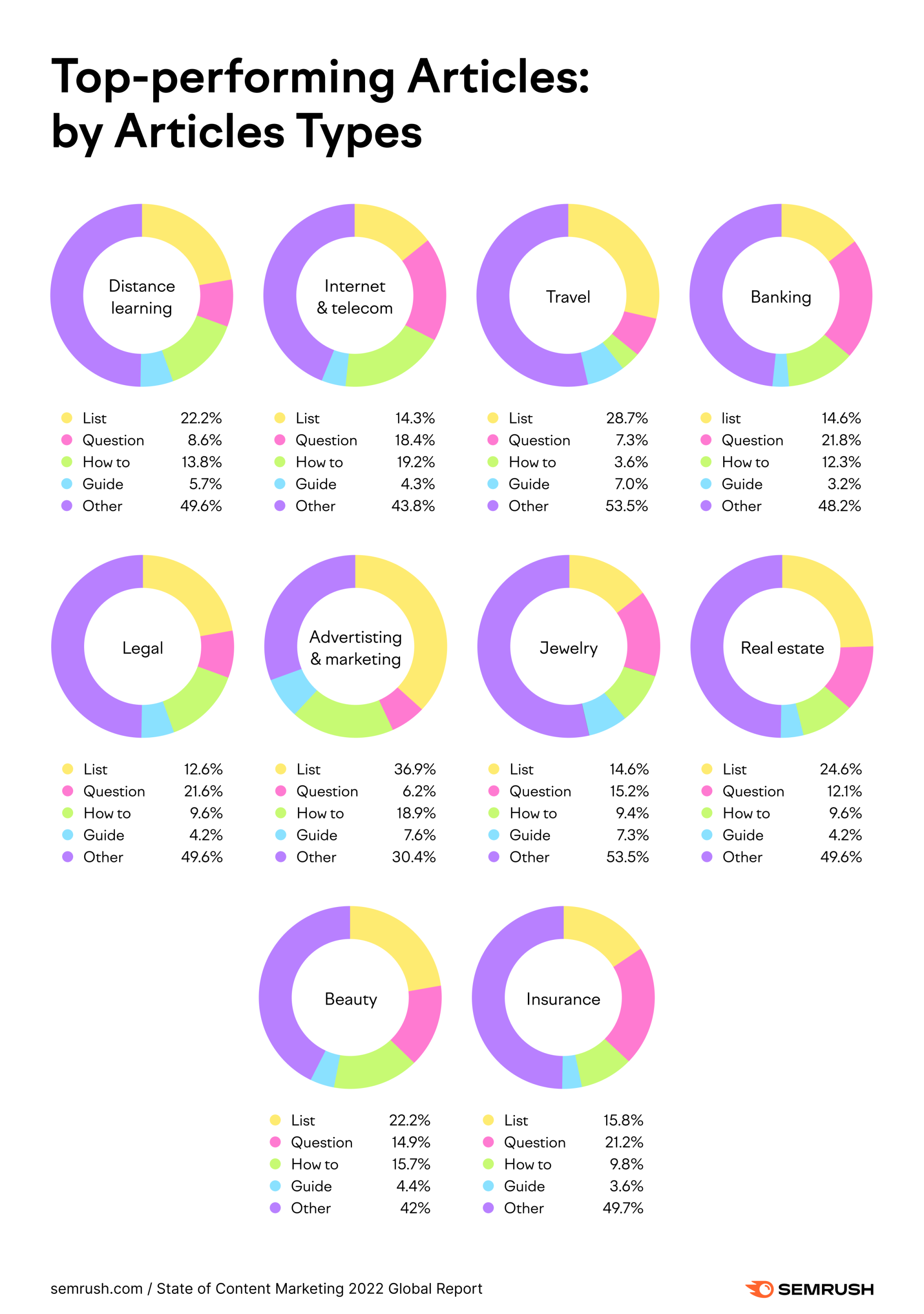
Key takeaway: Article titles featuring “list,” “question,” and “how to” perform effectively in many industry categories. Consider these formats for your content to address specific questions or answers your audience is looking for. Some perform better in certain industries, such as “lists” for travel-related content, and “questions” for legal or banking sectors. To learn more about these findings, check out our blog which covers the formula for high-performing content.
Industry Blogs Top-Performing Articles: by Number of Images
What we did: We analyzed the top blogs within each category to determine the average number of images per article.
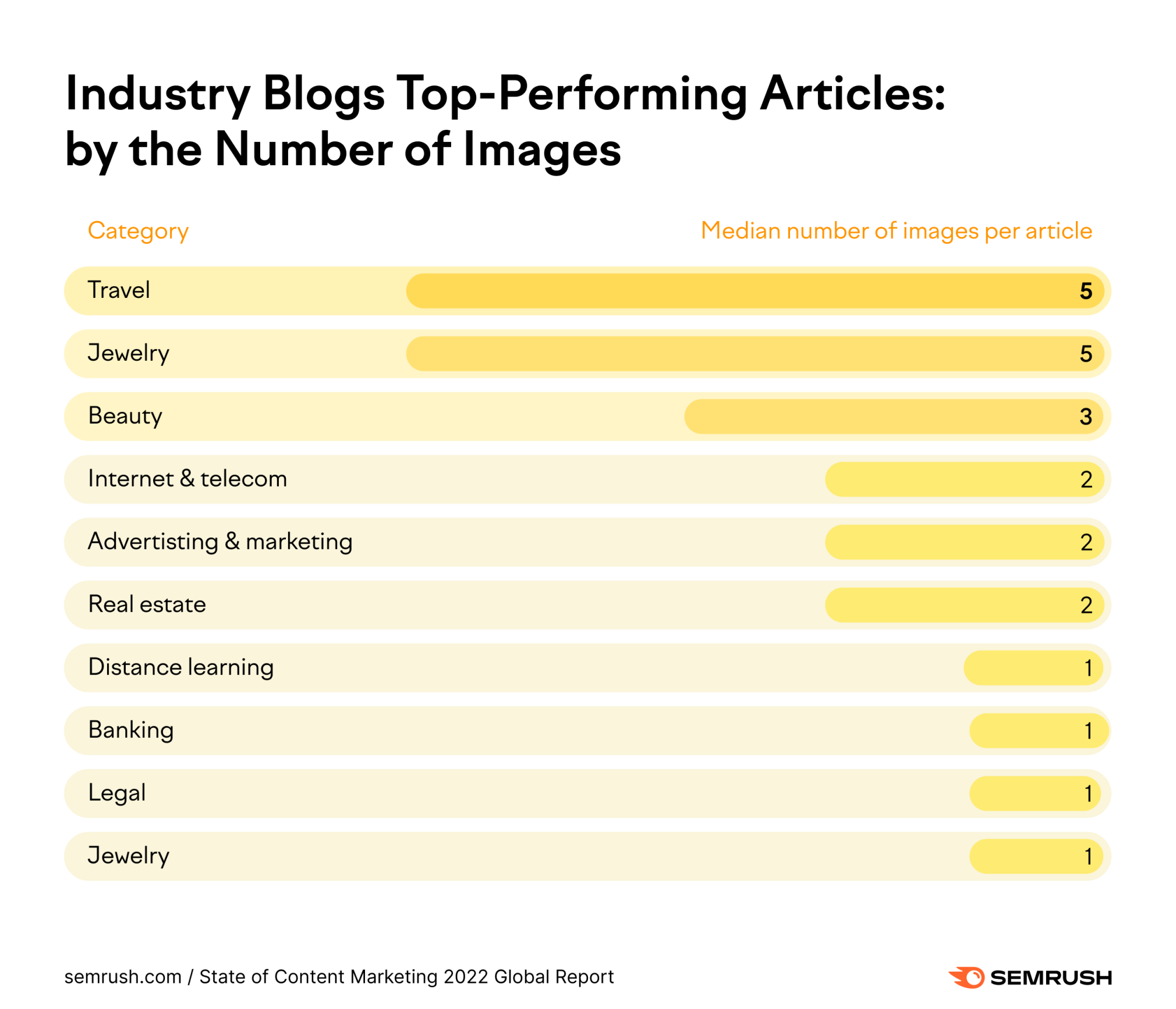
Key takeaway: Consumer industries (such as travel, jewelry, and beauty), lead the way in their use of visuals. Others range from one to three images per article, on average. Consider your audience and select your visuals carefully using these industry trends. For more information on images and performance, head over to this blog article.
Now that we’ve shared some common traits of top-performing content, we turn to experts who are executing winning strategies in very challenging verticals. To learn about wider content marketing trends, have a look at our recent research-driven article.
Tip #1: Perform Keyword Research and Keyword Gap Analysis
Andrea Corbito says:
With Semrush, we’re planning ahead to feature emerging keywords and topics at the time of year when search volume will be greatest. We’re filling in content gaps where we see competitors outperforming us on relevant keywords, and targeting niche topics with more specific, long-tail phrases that our audience is searching. In a niche industry, we expect to see this specific and competitive targeting drive our results and help us bring new prospects into our on-page customer journeys from search engines.
Businesses in niche industries such as agriculture face the challenge of targeting keywords with small search volume within a very competitive arena. But using tactics such as implementing more long-tail keywords as well as the content gap analysis has helped them win SEO gains for keywords as specific as “aquatic and sedge weeds.”
Andrea Corbito, Digital Content Manager at Corteva Agriscience, attributes long-tail keywords as the successful ingredient in building out content that resonates. One of the tactics they use is including additional components on some product pages: for example, FAQs and product comparison charts.
This provides them with more opportunities to hit on keywords and to answer questions Googled by their target audience.
Content marketers can apply this strategy across nearly any business line or industry. It allows you to oversee the creation of valuable content that addresses the needs of your audience and gets attention from search engines too.
Tip #2: Research and Create Content Based on Related Topics
Thompson Tee Inc. owns a patent called Hydro-Shield sweatproof technology. But how many people actually Google that?
Michelle Leung is a Senior Content Manager at Human Marketing, Thompson Tee’s agency of record. Her team’s approach focuses on finding related topics to build out larger content pieces that draw visitors from the attraction stage of the funnel.
Related topics are often questions that your audience may be asking or find intriguing—beyond those directly related to your offering. It’s an opportunity to get eyes on your content from those who may not have otherwise found you with a direct keyword search. For instance, innovative niche industries might benefit from this approach when they need to build demand for their product from scratch.
We created a comprehensive content marketing strategy largely driven by blogging. We implemented the topic cluster strategy and have seen successful results. We identify related topics that might be of interest to our target audience or educate them on other sweat solutions as a way to introduce our product as a better alternative.
Some of their most successful efforts have centered around topics such as the prevention and removal of sweat stains, hyperhidrosis (the medical term for excessive sweating), antiperspirant, deodorant, and underarm odor. With hundreds of published articles on these topics, they now place effort on optimizing existing content.
Using the Semrush Topic Research tool, you can look up relevant ideas to build out content topics using this strategy. For instance, let’s take a look at the subtopics related to ‘antiperspirant’.
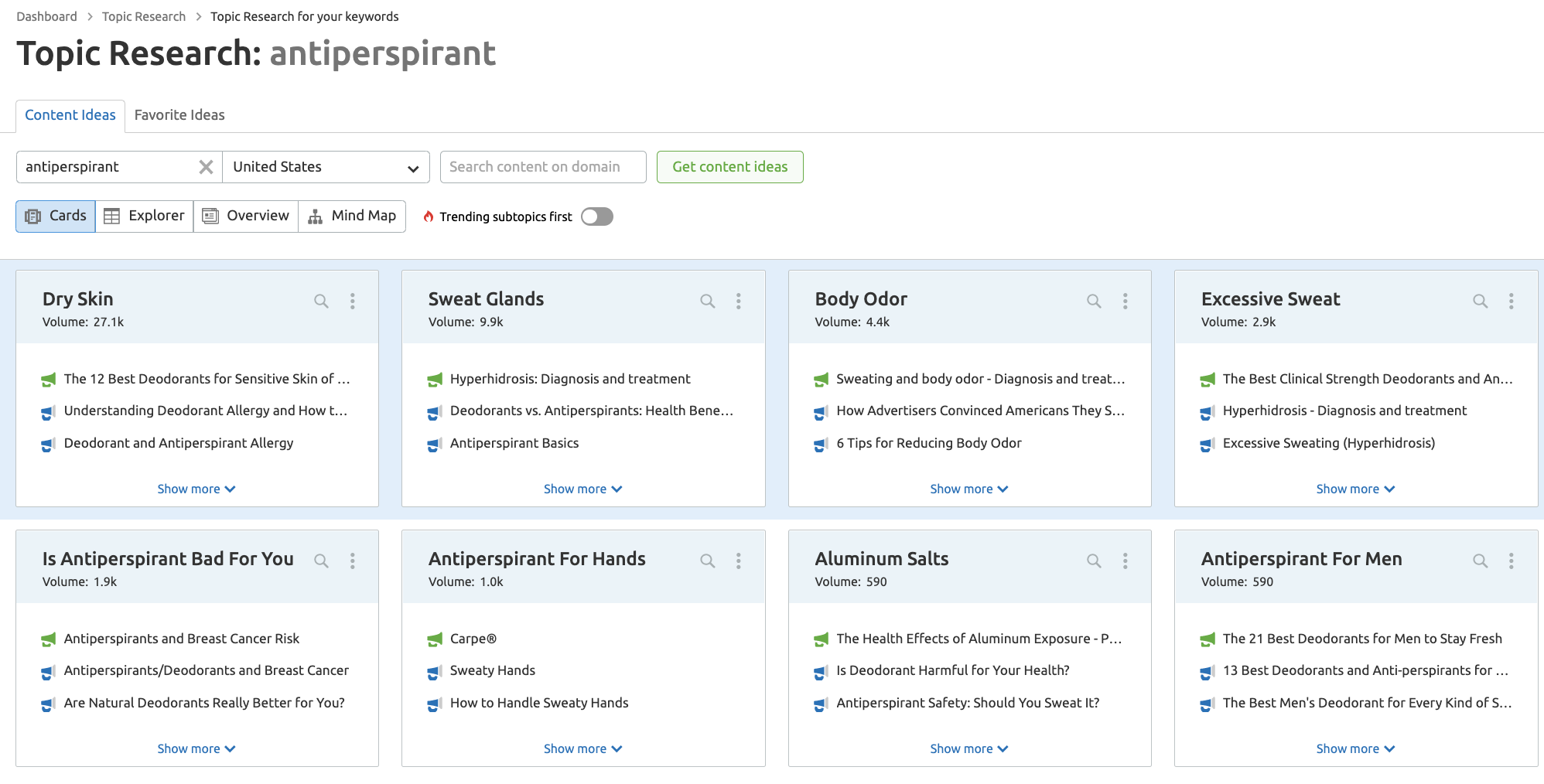
Then, you can take a few of these topic ideas and generate clusters of keywords with Keyword Strategy Builder.

It helps you find keywords for a strong content strategy with one click. It’s especially good for brainstorming when you’re in a rut.

Next time you find yourself struggling with a target keyword that may not garner much traffic volume, consider expanding your keyword and topic base to cast a wider net.
Tip #3: Repurpose Existing Content in Every Way Possible
Do you have a brilliant idea for a blog? Chances are, it could also make an impactful video, infographic, guide, or social post. Repurposing content into other formats is one of the most effective and economic best content marketing practices, because it leverages the great ideas you already have into new formats that perform on other channels.
Anam Siddiqui is a Content Marketing & SEO Manager at how.fm, a SaaS platform catering to the logistics and warehousing industry—an industry whose audience is mostly offline. Siddiqui’s team found content marketing success with these two considerations: asking “how valuable it is for our audience” and providing “expert advice.”
For content seeding, we repurposed our content as infographics and articles on LinkedIn, published original content on established industry publications, and focused on cross-promotion through B2B collaborations.
Like Siddiqui, content marketers can leverage existing content pieces into a multitude of formats that help reach your customers both online and offline. Some effective channels include:
- Direct mail
- Email blasts or monthly newsletters
- How-tos and product manuals
- Guest posts
- Infographics
- Pamphlets and rack cards
- Podcasts
- Social media campaigns
- Videos
- Webinars
Repurposing and converting your high-performing content pieces is also a tremendous way to save time. Rather than hashing out a dozen unique content marketing ideas or topics, focus on one and build it out a dozen different ways.
Tip #4: Invest in Placements in Niche Industry Publications
Megan Thudium at MTC | The Content Agency leans into expert voices through niche industry publications to unearth content marketing success.
If you’re doing your due diligence—writing content that targets the needs of your audience—your content will remain relevant and engaging. Audiences in niche B2B industries enjoy staying current with their industry, educating themselves, and reading original thoughts from other experts. Taking a thought-leadership approach in your content is a great way also to stay engaging.
Landing your company’s name in an industry publication, even if you have to spend money to do so, is an incredibly powerful way of getting your content seen by the most relevant players in your niche. To boot, it can help enhance your thought leadership and improve your brand’s reputation within your industry—to an already-receptive audience.
Tip #5: Promote and Amplify Your Content by Working with Influencers
“You can’t ignore respected voices, even if they aren’t hitting the high numbers in terms of followers and engagement,” explains Tim Meredith. Meredith is the Managing Director of Fractional Teams, a very niche technology solutions provider that leverages influencer marketing to boost and amplify their presence in this space.
There are a number of recognizable industry influencers that are highly respected in their specific niche who can add a great boost to promoted content by their inclusion. This niche may be an audience of <1000 followers but bear in mind that this is potentially 200-300 companies that require very specific solutions in the UK alone. Super niche, super valuable.
Not only do influencers increase the reach of your content, but their involvement is also a confidence-building tool for your brand. A study found that 71% of marketers believe that an external ambassador for your company is considered to be more trustworthy than self-promotional. Having the endorsement of a respected influencer gives your niche content more credibility in the eyes of your target audience.
Tip #6: Focus on Data and Customer Insights
“There are no shortcuts when it comes to content that cuts through to your audience,” claims Matt Allison, Founder and Managing Director at Ubiquity Lab.
Allison’s process to build a sophisticated content marketing strategy starts with data, powered by audience-centric content. Just like how a global behemoth might take this approach, it works identically within smaller, niche brands to drive content marketing results.
When it comes to content that truly lands with the audience, niche industries have an advantage. Not only do they have less competition from an SEO perspective, they’re usually closer to the customer. It’s this intimate understanding of the customer through data, combined with customer-led storytelling that is the ‘secret sauce’ to create content that cuts through.
Allison’s process follows these 10 steps:
- Start with data to diagnose audience intent
- Work with an experienced content marketer to consumerize data, ideate, and write powerful content
- Have a clear and unique angle that’s customized to your audience
- Take the time to write a killer headline
- Make every word count
- Interview great talent within your organization and externally to build credibility
- Do the work for your audience by simplifying complex information
- Optimize content for search
- Bring the story to life with powerful photos, infographics, videos, social tiles
- Have your work proofed by a subeditor
Rather than ideating content around general keywords, Allison focuses on bringing data insights in the form of compelling content that provides utility to the customer at each stage of their journey.
To illustrate, a client in the health insurance field needed to deliver a campaign surrounding endometriosis. By establishing search intent, and mapping out the customer journey, Allison developed helpful, empathetic, and medically-robust content to best support the audience’s needs.
“It was our most successful content campaign from a search perspective, with every single piece of content ranking on page one of Google within just four months,” says Allison.
It continues to drive free sustainable traffic, and also resulted in an increase in positive sentiment on social media. To learn more about this case study, read about the power of user intent and customer journey on their website.
If you’re struggling to create a process, try approaching your content marketing challenges with this framework in mind.
Tip #7: Work with Great Storytellers
Megan Anderle from LinkedIn underlines the importance of working with great storytellers to unearth the human element in every story you tell.
There’s a good reason why brands hire former journalists to lead their content marketing teams—it’s because they are expert storytellers who can find the interesting, human angle to stories, and many of them have great experience with SEO, so peppering in the right keywords is a natural part of their writing process. In heavily regulated industries where you’re limited by compliance and legal departments in what you can say in your copy, content teams have to be more creative in how they tell compelling stories.
Anderle says the best stories come from talking to a range of people at your company, and getting outside of your marketing team can reveal interesting takeaways.
By talking to your sales team, your operations, your research and development, you’ll get a wider range of topics, stories, and industry trends that speak to the heart of your industry. And that will put you one step closer into the mind of your target audience to build valuable content they can’t find anywhere else.
Tip #8: Go from Centralized and Broad to Local
Graham Williams is a Digital Marketing Specialist at Pipelife International, a supplier of piping products serving agriculture, infrastructure, and building industries in more than 25 countries.
We almost always start with planning a broader topic, for example, “Wind Energy” using Semrush, and we then take a look at local trends using the Topic Research tool. This allows our countries to find specific content topics that relate to the overall group-wide strategy.
To find winning content ideas, Graham says to develop a centralized content marketing strategy first, to consider broad topics, and only then to double down on local trends.
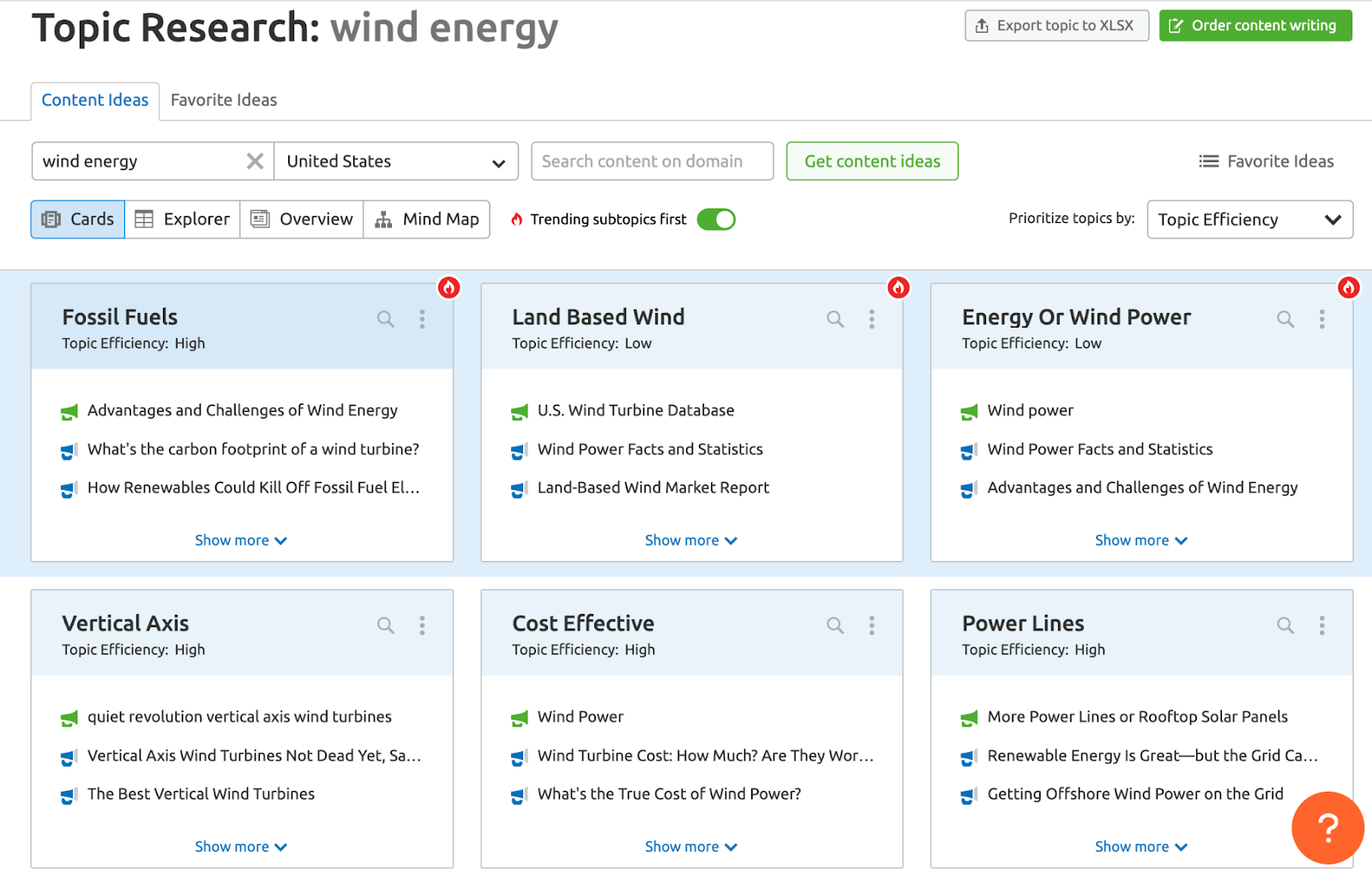
Just as Graham uses Topic Research in the quest for broad topics, the tool allows you to drill down to local levels, e.g., by region or city.
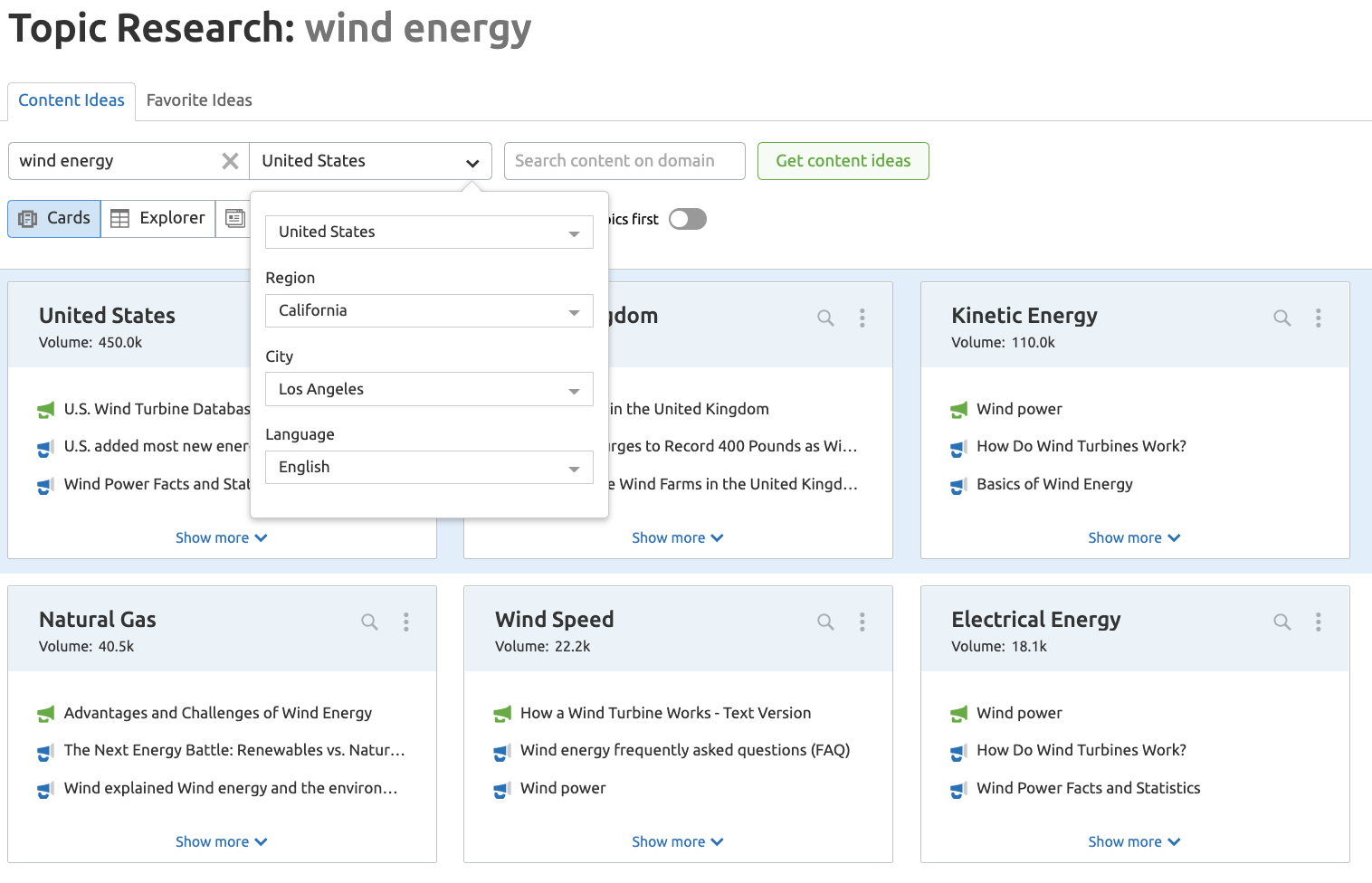
If your industry has a sprawling, international element to it like Graham’s niche, a centralized content strategy with both broad and locally-focused content topics can keep your audience engaged with the topics that impact them the most.
PRO TIP: Consider this strategy for creating a pillar page with local content in a cluster topic strategy. This allows you to explore centralized, broad, and local topics in a single, authoritative resource that your audience can refer to for in-depth coverage of their industry’s landscape.
Tip #9: Be an Educational Resource
Amber Erickson is the Head of Content at Flowhub, catering to a very challenging industry: cannabis.
Not only do federal restrictions limit what media companies allow advertising, but the cannabis industry is so new that it doesn’t even have its own business nomenclature. So how can you market this effectively?
Erickson focuses on delivering educational content to new dispensary owners.
Sourcing ideas is easy because there isn’t already a wealth of information available. My audience—dispensary owners—are looking for education, advice, and guidance, and in many cases, there isn’t easily-accessible information for them. It isn’t uncommon for me to create a thorough resource and hit the #1 spot in the SERPs almost immediately.
According to Erickson, another challenge is competing with high-volume keywords that are consumer-focused. For example, “cannabis delivery” is frequently searched by consumers wishing to have marijuana delivered to them—an entirely different audience and search intentthan dispensary owners.
Instead, Erickson capitalizes on the novelty of her industry and embraces the rare opportunity to be the first at introducing most topic ideas and trends. By basing content topics around industry trends and internal and external feedback from customers, Erickson says there’s no shortage of topics to tackle.
Tip #10: Give Subject Matter Experts (SMEs) the Byline
You can’t build thought leadership without talking to the experts first. Mindi Zissman, Founder of Zissman Media, is a ghostwriter specializing in risk, insurance, and compliance industries with an emphasis on B2B.
According to Zissman, the best content comes directly from the mouth of experts, and brands can leverage their thought leadership for their own content marketing gains.
Their ideas are directly from the field and are usually the most original because they’re out there every day solving the problems of your customers. TIP: Give the SMEs the byline. It increases the credibility of the content and when they share it on social media, the reach in your target audience is amplified.
SMEs have their own audiences and are also actively building their personal brand. Partnering with these powerful allies in your content strategy also helps them achieve their own goals, and for this reason, they’ll likely be willing and eager to work with you again. More thought leadership = more content!
To save this list of tips for the future, grab this infographic:

Final Thoughts: Creative Solutions for Niche Industries
No matter how large or small your industry may be, each company is unique and merits its own, dedicated content marketing strategy. Niche industry marketing doesn’t have to be so complicated. You can apply many of the same tactics that larger industries use to achieve content marketing success. We hope you gleaned some insights from our experts and comprehensive research; Make sure to check out the 2022 list of the top content marketing statistics and download the full State of Content Marketing 2022 Global Study.
